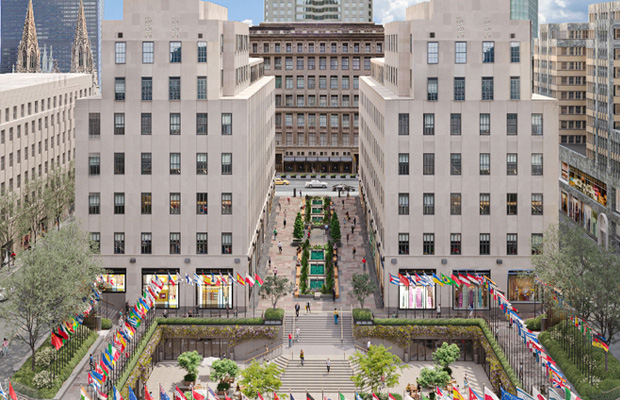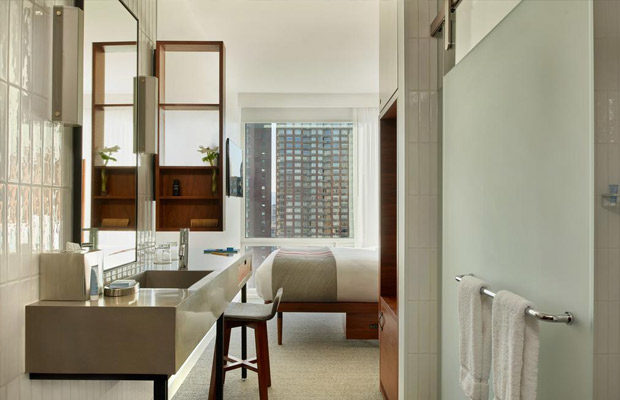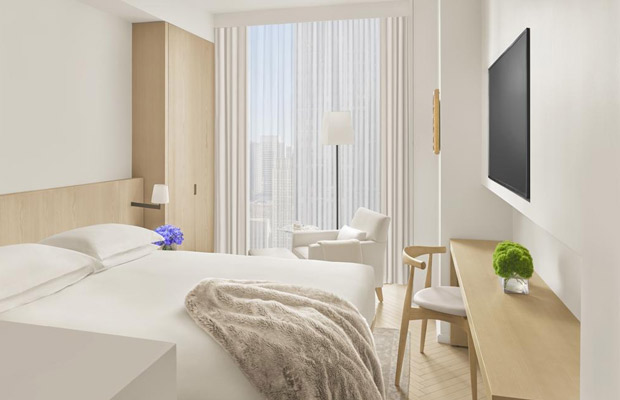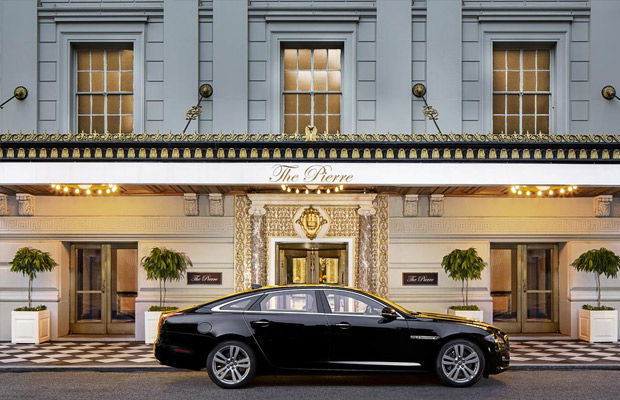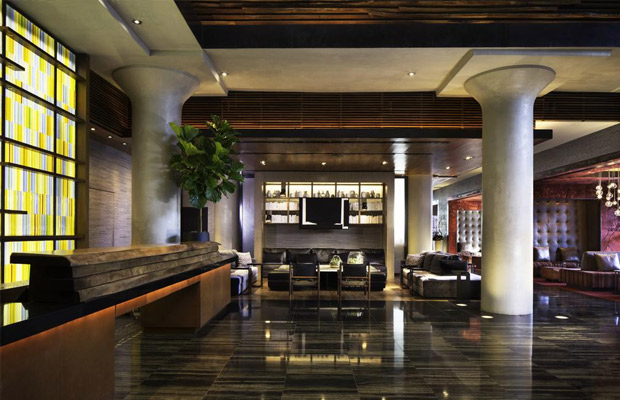Rockefeller Center
Rockefeller Center
USA
New York
New York Travel Guide
Book Tour & Activities
Your tour in New York.
Book your stay
Your hotel in New York.
Overview
Rockefeller Center is a large complex consisting of 19 commercial buildings covering 22 acres between 48th Street and 51st Street in Midtown Manhattan, New York City. The 14 original Art Deco buildings, commissioned by the Rockefeller family, span the area between Fifth Avenue and Sixth Avenue, split by a large sunken square and a private street called Rockefeller Plaza. Later additions include 75 Rockefeller Plaza across 51st Street at the north end of Rockefeller Plaza, and four International Style buildings located on the west side of Sixth Avenue.
In 1928, the site's then-owner, Columbia University, leased the land to John D. Rockefeller Jr., who was the main person behind the complex's construction. Originally envisioned as the site for a new Metropolitan Opera building, the current Rockefeller Center came about after the Met could not afford to move to the proposed new building. Various plans were discussed before the current one was approved in 1932. Construction of Rockefeller Center started in 1931, and the first buildings opened in 1933. The core of the complex was completed by 1939. The original center has several sections.
History
The first private owner of the site was physician David Hosack, who purchased twenty acres of rural land from New York City in 1801 for $5,000 and opened the country's first botanical garden, the Elgin Botanic Garden, on the site.[8][9][10] The gardens operated until 1811,[11][12] and by 1823, ended up in the ownership of Columbia University. Columbia moved its main campus north to Morningside Heights by the turn of the century.
In 1926, the Metropolitan Opera started looking for locations to build a new opera house to replace the existing building at 39th Street and Broadway. By 1928, Benjamin Wistar Morris and designer Joseph Urban were hired to come up with blueprints for the house.[17][18] However, the new building was too expensive for the Met to fund by itself,[2] and John D. Rockefeller Jr. eventually gave his support to the project (John D. Rockefeller Sr., his father, was not involved). Rockefeller hired Todd, Robertson and Todd as design consultants to determine its viability.[3][20] John R. Todd then put forth a plan for the Met.[21][22] Columbia leased the plot to Rockefeller for 87 years at a cost of $3 million per year. The initial cost of acquiring the space, razing some of the existing buildings, and constructing new buildings was estimated at $250 million.[23] The lease initially excluded a strip along Sixth Avenue on the west side of the plot, as well as another property on Fifth Avenue between 48th and 49th streets.
Rockefeller hosted a "symposium" of architectural firms to solicit plans for the complex, but it did not yield any meaningful plans. He ultimately hired Corbett, Harrison & MacMurray; Hood, Godley & Fouilhoux; and Reinhard & Hofmeister, to design the buildings. They worked under the umbrella of "Associated Architects" so none of the buildings could be attributed to any specific firm. The principal builder and "managing agent" for the massive project was John R. Todd, one of the co-founders of Todd, Robertson and Todd.[30] The principal architect and leader of the Associated Architects was Raymond Hood, a student of the Art Deco architectural movement.[5][6] The other architects included Harvey Wiley Corbett[5] and Wallace Harrison.[31] L. Andrew Reinhard and Henry Hofmeister had been hired by John Todd as the "rental architects", who designed the floor plans for the complex.
The Metropolitan Square Corporation (the precursor to Rockefeller Center Inc.) was formed in December 1928 to oversee construction.[33][28] However, the Metropolitan Opera wanted to hold out for a more favorable lease because it worried about the site's profitability.[21][34] After the stock market crash of 1929, the Metropolitan Opera could not afford to move anymore,[28] and on December 6, 1929, the plans for the new opera house were abandoned completely.[21][35][36] In order to make a profit on the site as quickly as possible, Rockefeller devised new plans within a month so that the site could become profitable. The developers entered into talks with Radio Corporation of America (RCA) and its subsidiaries, National Broadcasting Company (NBC) and Radio-Keith-Orpheum (RKO), to build a mass media entertainment complex on the site. By May, RCA and its affiliates had made an agreement with Rockefeller Center managers to lease space and develop part of the complex.
Todd released a new plan "G-3" in January 1930. Two months later, an "H plan" was released with facilities for "television, music, radio, talking pictures and plays", as well as four theaters. Under Rockefeller's plan, the demolition of the site's existing structures would start in the fall, and the complex would be complete by 1933.[48] Another plan was announced in March 1931, but the proposal received mostly negative feedback from the public. An oval-shaped building with rooftop gardens, included in the original plan, was later replaced with four small retail buildings and a 41-story tower, comprising the current International Complex. The updated plan also included rooftop gardens[59][60] and a recessed central plaza. The International Complex was eventually occupied by British, French, and Italian tenants, leading to its current name. The design of the complex was affected greatly by the 1916 Zoning Resolution, which required setbacks to all high street-side exterior walls of New York City buildings in order to increase sunlight for city streets.
During early planning, the development was often referred to as "Radio City", "Rockefeller City", or "Metropolitan Square" (after the Metropolitan Square Corporation). Ivy Lee, the Rockefeller family's publicity adviser, suggested changing the name to "Rockefeller Center". John Rockefeller Jr. initially did not want the Rockefeller family name associated with the commercial project, but was persuaded on the grounds that the name would attract far more tenants. The name was formally changed in December 1931. Over time, the appellation of "Radio City" devolved from describing the entire complex to just the complex's western section,[4] and by 1937, only the Radio City Music Hall contained the "Radio City" name.
Video Travel Inspiration
See Rockefeller Center on Map
Most Popular Cities

Siem Reap
Cambodia
Ho Chi Minh City
Vietnam
Beijing
China
Paris
France
London
United Kingdom
New York
USA
Tokyo
Japan
Bangkok
Thailand
Seoul
South Korea
Vientiane
Laos
Yangon
Myanmar
Washington DC
USA
Los Angeles
USA
Ottawa
Canada
New Delhi
India
Singapore
Singapore
Kuala Lumpur
Malaysia
 English
English French
French Khmer
Khmer Thai
Thai Vietnamese
Vietnamese Chinese
Chinese Korean
Korean German
German Japanese
Japanese Italian
Italian Russian
Russian Spanish
Spanish Dutch
Dutch Indonesian
Indonesian Malay
Malay
